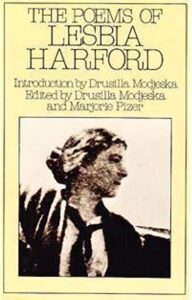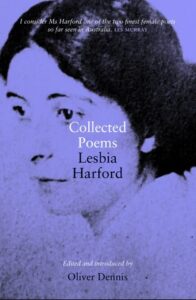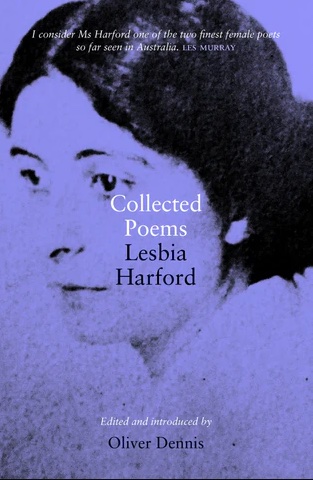by Jonathan Shaw We have made Jonathan our go-to for poets and poetry. Sending in this essay on Melbourne poet, writer, and activist Lesbia Harford he wrote: “It’s been a real treat getting to know her work.”
We have made Jonathan our go-to for poets and poetry. Sending in this essay on Melbourne poet, writer, and activist Lesbia Harford he wrote: “It’s been a real treat getting to know her work.”
Lesbia Harford is far from forgotten or overlooked. You could even argue that, for an Australian woman poet, she has received a lot of attention. H M Green’s monumental History of Australian Literature, Volume II (1961) devoted four pages to her, but a decade later she was completely absent from Harry Heseltine’s Penguin Book of Australian Verse (1972). These days, she is dependably included in historical anthologies, and her poems turn up on sites like allpoetry.com and poemhunter.com. Yet it’s unlikely that many readers of this blog will be familiar with her work. And that’s a shame.
Lesbia Harford, nee Keogh (1891–1927) was born into a middle-class Melbourne family that fell on hard times when her alcoholic father deserted them. She suffered from a congenital heart condition that meant her health was always an issue. She was an active and much-loved part of Melbourne’s small intellectual circle. At university in 1914 she often engaged in heated debate with the young Robert Menzies. She had a passionate, life-long relationship with Kate Lush, a Philosophy lecturer at Melbourne University. She had a close friendship with Communist Guido Baracchi (the subject of Jeff Sparrow’s Communism, A Love Story), and for a time they were lovers. She was a unionist , and joined the International Workers of the World – the Wobblies. Despite her physical frailty she decided on ethical grounds to work for years as a machinist in a clothing factory. In her brief marriage to a socialist activist and artist, she endured domestic violence. She tutored students in English literature. She completed a law degree, a rare achievement for a woman at that time, intending to use it to work for social justice, but she died before she could fully qualify as a lawyer. She was an intellectual, an ex-Catholic, a factory worker, an activist, a free spirit, a lover, a tutor and a student: all of these fed her poetry.
 When she died in her mid thirties, she had published very little poetry. Three collections have been published since, in 1941, 1985 and 2014, each containing more poems than the previous one, and roughly 200 more of her poems exist only in notebooks held in the Mitchell Library in Sydney. (Her novel, The Invaluable Mystery, which was published in 1987 by McPhee Gribble with a foreword by Helen Garner, must wait for another blog post.)
When she died in her mid thirties, she had published very little poetry. Three collections have been published since, in 1941, 1985 and 2014, each containing more poems than the previous one, and roughly 200 more of her poems exist only in notebooks held in the Mitchell Library in Sydney. (Her novel, The Invaluable Mystery, which was published in 1987 by McPhee Gribble with a foreword by Helen Garner, must wait for another blog post.)
Harford’s increased profile is probably due in part to a general shift in the culture. For example, when a lecturer on Australian modernist painting recently failed to mention any women artists, their student audience was scathingly vocal. There are good grounds for hope that a similar response would today meet an anthologist who, like Heseltine, included Peter Hopegood (Peter who? I hear you ask) but not Lesbia Harford. The general change was made particular in Harford’s case by work done by Marjorie Pizer over many years, culminating in the publication of Poems of Lesbia Harford (Sirius Books 1985), which she edited with Drusilla Modjeska. The book includes a number of photos, and Modjeska’s introduction gives a lively account of Harford’s life and work. If you can find a copy (no easy task), I recommend it.
Over the decades since her death, Harford has been viewed through many lenses.
In 1942, an anonymous, probably male reviewer in the Sydney Morning Herald wrote what was meant to be dismissive, but these days reads like praise:
There is … an absence of what one would call poetry. Moments of perceptions are recorded in her verse, crystallisations of feeling, but rarely in ‘words that burn’. In fact, the book reads rather like a rhymed diary.
‘Poet from the Past‘, Sydney Morning Herald 2 May 1942, page 6
In 1961, H M Green wrote that she was ‘a pure lyrist’ and went on:
Almost half her collected poems deal with love; in a sense indeed they all do, for she differs from many other social reformers in that the motive of her enthusiasm was love, in its largest sense.
in 1985, Drusilla Modjeska wrote:
Her voice, unmistakably her own, speaks as part of the multiplicity of voices speaking about social injustice, hope for revolution and the contradictory experiences of women.
In 2014, Les Murray, presumably without intending the compliment to be backhanded, pronounced:
I consider Ms Harford … as one of the two finest female poets so far seen in Australia.
In the same year, Jeff Sparrow echoed the anonymous 1942 reviewer’s ‘rhymed diary’ comment, but with a completely different implied judgement (one that I agree with):
She often wrote about – and occasionally to – her friends and associates, referencing both public events and personal triumphs and sorrows. Like other private documents, the poems demand to be read in context – a context that, in Harford’s case, is not always obvious, both because the biographical record remains sketchy and, perhaps more importantly, because our historical moment is so different.
Sydney Review of Books 16 September 2014
Sparrow’s comment is reinforced by the way the poems have reached us. In all three published collections, as in Harford’s notebooks, they are organised in chronological order (though the most recent and largest of them, Oliver Dennis’s 2014 edition, doesn’t give dates). So it’s tempting, often appropriate, and even necessary to read the books as elliptical autobiographies or memoirs that touch on world events as well as intimate ones. My own experience of the poems bears this out: read in isolation in anthologies or on poetry websites, they have little of the power they have when read together, in order.
 Readers so far might get the impression that reading Lesbia Harford is like visiting the Poetry Museum. My aim in the rest of this blog post is to demonstrate that it’s not like that at all, by showing some small examples. Here’s the first of her poems that I read:
Readers so far might get the impression that reading Lesbia Harford is like visiting the Poetry Museum. My aim in the rest of this blog post is to demonstrate that it’s not like that at all, by showing some small examples. Here’s the first of her poems that I read:
People sometimes tease me, saying
I have lovers many.
If I lack the one I sigh for,
What’s the good of any?
I will never have a lover,
Though I am so bonny.
Love could only hurt that showed me
What I miss from Johnny.
Like many or even most of Harford’s poems, this looks and at first feels like light verse. It starts out as a jaunty, even frivolous rhyme. Then the tone deepens: the poem moves from a lively social circle, to reflecting on the relative value of good-time companionship and true love, to a rejection of the idea of having a lover at all, and then in the final lines, so calmly that it could be missed altogether, a bereavement is revealed. Read without context, it’s subtle and moving. If you read it as a poem from the home front of the First World War, it has a kind of devastating whiplash effect.
You may not read it that way, and it’s a strength of these poems that they don’t insist on a particular reading. The fairly early poem, ‘My mission in the world’ is explicit:
No marble meaning’s mine
Fixed for a school,
My singing ecstasy
Winged for the flight,
Each will hear differently
And hear aright.
That idea sounds awfully modern, even while it’s framed in pre-modern rhyming verse. Yet, even while the poems don’t insist on a single reading, they draw much of their power from their truthfulness. This tiny enigmatic offering is an example:
I have three loves who are all most dear.
Each one has cost me many a tear.
The one who is dead yet lives in me.
I were too poor had I less than three.
We don’t have to know names and dates to believe this is based in experience. It’s not naive: but while it defies what these days we would call something like monogamous heteronormativity (other poems make it clear that one of the loves is a woman), it still reads as a simple, fresh statement of an emotional reality.
There are surprisingly explicit poems about menstruation, ‘Periodicity’ I, II and III. This is the first of them:
Each month I go
Fathoms deep, ocean-whelmed, in woe.
Then agony, hopelessness roll
Wave-deep over body and soul,
Then pain’s my familiar, darkness my friend,
And Time has no end.
Yet once again
I rise born anew from my pain.
Soul, body take radiant form.
Aphrodite-like out of the storm
I emerge. In their issue are blest
Those waves without rest
When I read that to my partner, she didn’t respond as if the poem was a hundred years old. She said, ‘She’s got endometriosis.’
A little poem about rowdy factory girls on the way home from work, snippets of conversation between machinists at work, a rhyme about missing a lover, a narrative of going for a swim just before dawn, a note on the weather – any one of these will draw the reader in, then turn at the last moment without breaking a sweat and leave you gasping or, sometimes, wondering if you just imagined that the poem did what you think it did.
References:
The Poems of Lesbia Harford, edited by Nettie Palmer (Angus & Robertson 1941)
Poems of Lesbia Harford, edited by Marjorie Pizer and Drusilla Modjeska (Sirius Press 1985)
Collected Poems: Lesbia Harford, edited by Oliver Dennis with a foreword by Les Murray (UWAP 2014)
H M Green, A History of Australian Literature: Volume II, 1923–1950 (Angus & Robertson 1961), pages 951–955
Gary Catalano, ‘Lesbia Harford’, Quadrant, December 1998, p. 53
Jeff Sparrow, Communism, a Love Story (MUP 2007), especially pages 67–93
Jeff Sparrow, ‘Render it barely: Collected Poems: Lesbia Harford‘, Sydney Review of Books,16 September 2014
Jonathan Shaw is another old white guy, with an ancient degree in Eng Lit. He’s the former editor of a children’s literary magazine who blogs at Me Fail? I Fly! about his joy in reading literature mainly written for adults.






I’ve always been a big fan of the Wobblies, so Harford can be my favourite poet on that basis alone, but I think your analysis of her verse shows that her poetry stands up on its own. I especially like the idea of a memoir in verse and will keep an eye out for a copy.
Thanks, Bill. Jeff Sparrow’s article makes some interesting observations about her connection to the Wobblies, mainly taking issue with Les Murray’s apparent assumption that they were a straight-laced mob of wowsers.
Such a generous and interesting introduction to Hartford’s work. Thanks, Jonathan.
Thank you
Oh, I did enjoy this Jonathan even if I’m only catching up now. This “leave you gasping or, sometimes, wondering if you just imagined that the poem did what you think it did.” made me rueful, because I often finish a poem thinking that, and fearing that I really did just imagine it.
Anyhow, I hope you might post on the novel for us one day? Was that a promise?
Oh, and who was the other woman poet that curmudgeon Murray (though I do like him too!) approved of – Wright? Or?